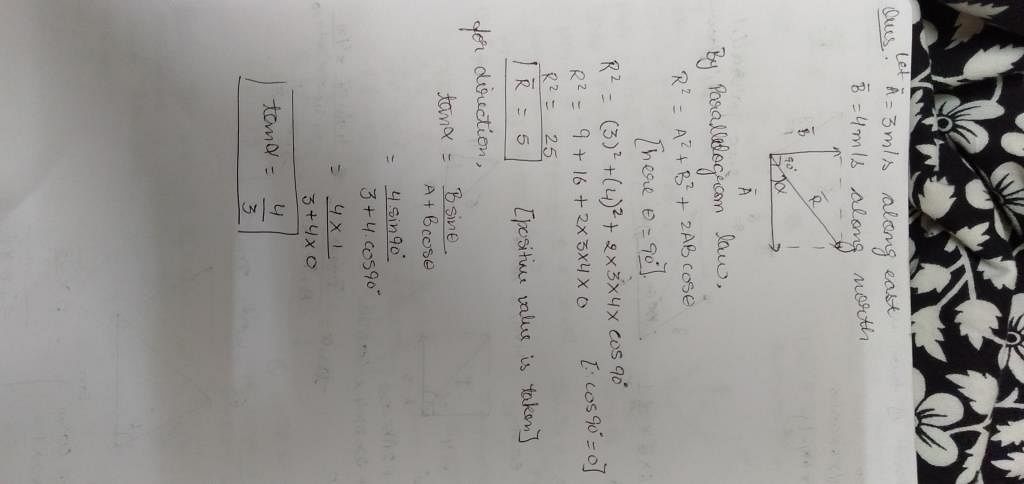Class 11 Exam > Class 11 Questions > Find the resultant of two velocities 3m/s alo...
Start Learning for Free
Find the resultant of two velocities 3m/s along east and 4m/s along north?
Most Upvoted Answer
Find the resultant of two velocities 3m/s along east and 4m/s along no...
Finding the Resultant of Two Velocities
When two velocities act on an object at the same time, the resultant velocity is the vector sum of the two velocities. To find the resultant velocity, we need to:
- Identify the direction and magnitude of each velocity
- Convert the velocities into vector form
- Add the vectors using vector addition
- Find the magnitude and direction of the resultant vector
Given Information:
- Velocity 1: 3m/s along east
- Velocity 2: 4m/s along north
Converting Velocities into Vector Form
We can represent the given velocities as vectors in a two-dimensional coordinate system, where:
- East is the positive x-axis
- North is the positive y-axis
Velocity 1 can be represented as:
v1 = 3m/s i
where i is the unit vector in the direction of the positive x-axis.
Velocity 2 can be represented as:
v2 = 4m/s j
where j is the unit vector in the direction of the positive y-axis.
Adding the Vectors using Vector Addition
We can add the vectors using vector addition, where:
v = v1 + v2
Substituting the values of v1 and v2, we get:
v = 3m/s i + 4m/s j
We can represent v as a vector in the same coordinate system:
v = 3m/s i + 4m/s j = (3,4)
Finding the Magnitude and Direction of the Resultant Vector
The magnitude of the resultant vector can be found using the Pythagorean theorem:
|v| = sqrt(3^2 + 4^2) = 5m/s
The direction of the resultant vector can be found using trigonometry:
tan(theta) = 4/3
theta = tan^-1(4/3) = 53.13 degrees
Therefore, the resultant velocity is 5m/s at an angle of 53.13 degrees north of east.
Community Answer
Find the resultant of two velocities 3m/s along east and 4m/s along no...
The Answer is 5. Either we use Head- tail method or Parallelogram law the answer will be same. Using Parallelogram law we can also find out its direction.Hope it helps.

Attention Class 11 Students!
To make sure you are not studying endlessly, EduRev has designed Class 11 study material, with Structured Courses, Videos, & Test Series. Plus get personalized analysis, doubt solving and improvement plans to achieve a great score in Class 11.

|
Explore Courses for Class 11 exam
|

|
Similar Class 11 Doubts
Find the resultant of two velocities 3m/s along east and 4m/s along north?
Question Description
Find the resultant of two velocities 3m/s along east and 4m/s along north? for Class 11 2024 is part of Class 11 preparation. The Question and answers have been prepared according to the Class 11 exam syllabus. Information about Find the resultant of two velocities 3m/s along east and 4m/s along north? covers all topics & solutions for Class 11 2024 Exam. Find important definitions, questions, meanings, examples, exercises and tests below for Find the resultant of two velocities 3m/s along east and 4m/s along north?.
Find the resultant of two velocities 3m/s along east and 4m/s along north? for Class 11 2024 is part of Class 11 preparation. The Question and answers have been prepared according to the Class 11 exam syllabus. Information about Find the resultant of two velocities 3m/s along east and 4m/s along north? covers all topics & solutions for Class 11 2024 Exam. Find important definitions, questions, meanings, examples, exercises and tests below for Find the resultant of two velocities 3m/s along east and 4m/s along north?.
Solutions for Find the resultant of two velocities 3m/s along east and 4m/s along north? in English & in Hindi are available as part of our courses for Class 11.
Download more important topics, notes, lectures and mock test series for Class 11 Exam by signing up for free.
Here you can find the meaning of Find the resultant of two velocities 3m/s along east and 4m/s along north? defined & explained in the simplest way possible. Besides giving the explanation of
Find the resultant of two velocities 3m/s along east and 4m/s along north?, a detailed solution for Find the resultant of two velocities 3m/s along east and 4m/s along north? has been provided alongside types of Find the resultant of two velocities 3m/s along east and 4m/s along north? theory, EduRev gives you an
ample number of questions to practice Find the resultant of two velocities 3m/s along east and 4m/s along north? tests, examples and also practice Class 11 tests.

|
Explore Courses for Class 11 exam
|

|
Signup for Free!
Signup to see your scores go up within 7 days! Learn & Practice with 1000+ FREE Notes, Videos & Tests.

























